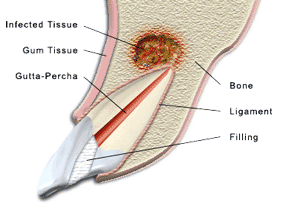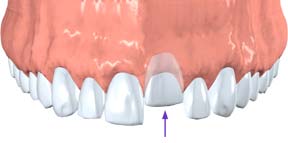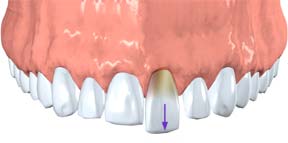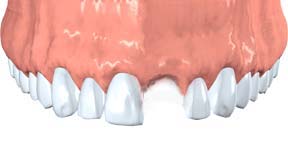|
WHAT IS A ROOT CANAL?
A root canal is
one of the most common dental procedures performed, well over 14 million every
year. This simple treatment can save your natural teeth and prevent the need of
dental implants or bridges.
At the center of
your tooth is the pulp. The pulp is a collection of blood vessels that helps to
build the surrounding tooth. Infection of the pulp can be caused by trauma to
the tooth, deep decay, cracks and chips, or repeated dental procedures. Symptoms
of the infection can be identified as: visible injury or swelling of the tooth,
sensitivity to temperature or pain in the tooth and gums.
How is a root
canal performed? If you experience any of these symptoms, your dentist will most
likely recommend non-surgical treatment to eliminate the diseased pulp. This
injured pulp is removed and the root canal system is thoroughly cleaned and
sealed. This therapy usually involves local anesthesia and may be completed most
of the time in one visit depending on the complexity of the case. Success for
this type of treatment occurs in about 90 to 95% of cases. If your tooth is not
amenable to endodontic treatment or the chance of success is unfavorable, you
will be informed at the time of consultation or when a complication becomes
evident during or after treatment. We use local anesthesia to eliminate
discomfort. You will be able to drive home after your treatment, and you
probably will be comfortable returning to your normal routine.
APICOECTOMY (
ENDODONTIC SURGERY)
Overview
|
 |
Why would I need Endodontic Surgery? Generally, a root canal is all that is
needed to save teeth with injured pulp from extraction. Occasionally, this
non-surgical procedure will not be sufficient to heal the tooth and your
endodontist will recommend surgery. Endodontic surgery can be used to locate
fractures or hidden canals that do not appear on x-rays but still manifest
pain in the tooth. Damaged root surfaces or the surrounding bone may also be
treated. The most common surgery used to save damaged teeth is an
apicoectomy or root-end resection. |
What
is an Apicoectomy?
The
above diagram illustrates this simple procedure. An incision is made in the gum
tissue to expose the bone and surrounding inflamed tissue. The damaged tissue is
removed along with the end of the root tip. A root-end filling is placed to
prevent reinfection of the root and the gum is sutured. The bone naturally heals
around the root over a period of months restoring full function.
Following the procedure, there may be some discomfort or slight swelling while
the incision heals. This is normal for any surgical procedure. To alleviate any
discomfort, an appropriate pain medication will be recommended. If you have pain
that does not respond to medication, please call our office.
CRACKED TEETH
Cracked teeth demonstrate many types of symptoms, including pain when chewing,
temperature sensitivity, or even the release of biting pressure. It is also
common for pain to come and go, making it difficult to diagnose the cause of
discomfort.
Chewing can cause movement of the cracked pieces of your tooth, and the pulp
within the tooth becomes irritated. At the same time, when biting pressure is
released, the crack can close quickly, resulting in sharp pain. Eventually, the
pulp will become damaged and tooth will consistently hurt, even when you are not
chewing. It is possible that cracks can lead to infection of the pulp tissue,
which can spread to the bone and gum surrounding the problematic tooth.
Types
of Cracked Teeth
Craze
lines
These
are tiny cracks that only affect the outer enamel of the tooth. These cracks are
more common in adults. These types of cracks are superficial and are usually of
no concern.
|

|
Fractured Cusp
When a cusp becomes weakened, a fracture may result. The cusp may break off
or be removed by a dentist. A fractured cusp rarely damages the pulp, so
root canal is not necessary. Your dentist will usually restore the tooth
with a full crown. |
|

|
Cracked Tooth
This type of crack extends from the chewing surface of the tooth and
vertically migrates towards the root. In some cases, the crack may extend
below the gum line. It is possible for the crack to extend further into the
root. Damage to the pulp is common place. In this case, root canal treatment
is usually necessary. A cracked tooth that is not treated will worsen,
resulting in the loss of the tooth. Therefore, early detection is essential.
|
|

|
Split Tooth
Split tooth is usually the result of an untreated cracked tooth. It can be
identified by a crack with distinct segments. This type of tooth can never
be saved intact. Yet, the position and extent of the problem will dictate
whether any portion of the tooth can be saved. Sometimes, endodontic
retreatment by Doctor Abdennour and restoration by your general dentist can
be used to save a portion of the tooth. |
|

|
Vertical Root Fracture
A
vertical root fracture begins at the root and extends towards the chewing
surface of the tooth. Unfortunately, they show minimal symptoms and may go
unnoticed. Treatment involves endodontic surgery if a portion of the tooth
can be saved by removal of the fractured root. Otherwise the tooth will have
to be extracted. |
TRAUMATIC INJURIES
|
|
Dislodged Teeth
Injuries to the mouth can cause teeth to be pushed back into their
sockets. Your endodontist or general dentist may reposition and
stabilize your tooth. Root canal treatment is usually started within a
few weeks of the injury and a medication, such as calcium hydroxide,
will be placed inside the tooth. Eventually, a permanent root canal
filling will be implanted. |
 |
|
 |
Sometimes a tooth may be pushed partially out of the socket. Again, an
endodontist or a general dentist may reposition and stabilize your
tooth. If the pulp remains healthy, then no other treatment is
necessary. However, if the pulp becomes damaged or infected, root
canal treatment will be required. |
|
Avulsed Teeth
If an injury causes a tooth to be completely knocked out of your
mouth, it is important that you are treated immediately! If this
happens to you, keep the tooth moist. If possible, put it back into
the socket. A tooth can be saved if it remains moist. You can even put
the tooth in milk or a glass of water (add a pinch of salt.) Your
Endodontist may start root canal treatment based upon the stage of
root development. The length of time the tooth was out of your mouth
and the way the tooth was stored, may influence the type of treatment
you receive. |
 |
|
|









